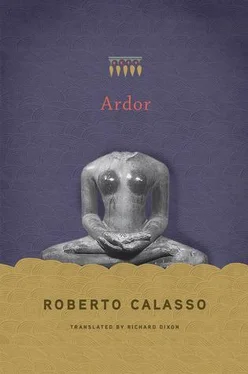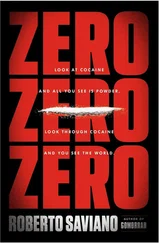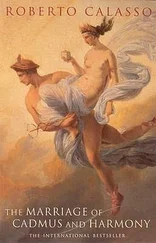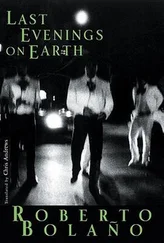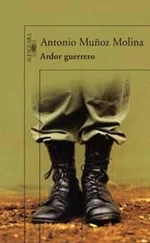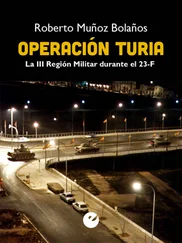Such was the terror of discontinuity — and of the injury implicit in every interruption — that they resorted, in the end, to the ultimate weapon of etymology to make it clear: they derived the word adhvara (“worship,” that which the adhvaryu practices) from the verb dhūrv- , “to injure.” Meaning by this that “the Asuras, though desiring to injure them, were unable to injure them and were foiled: for this reason the sacrifice is called adhvara , not damaged, uninterrupted.” And so the adhvaryu can only murmur, accompanying his constant acts with a buzz in which the individual words are unrecognizable. If he were to articulate them more clearly, he would risk losing his breath, which is life, since the formulas are breath — and the breath “resides in a silent abode.” The power of the adhvaryu is concentrated in the indistinct: “All that he carries out in a very low voice, when it is finished and complete, becomes manifest.” For something to assume its purest and clearest form, it has to be born out of something impenetrable, opaque, boundless.
* * *
Residue is the memory, the enduring presence of the insuppressible continuum. Whatever kind of order is established, in whatever context and of whatever kind, that order will leave something outside itself — and will have to leave that thing outside if it purports to be an order. That something outside order is residue, but also surplus. Residue is what is left out, surplus is the part left out which is offered up. The meaning of order lies, first and foremost, not in the way the order itself is arranged but in what that order determines to do with the part that does not belong to it. Offer it up? Consume it? Throw it away? That is the part which is cursed and blessed. And depending on what is decided to be done with it, the newly established order acquires meaning. Taken by themselves, as a simple formal configuration, all orders are equivalents, insofar as all coexist at the same level, like crystals cut in various ways. Considered in terms of what is outside them — residue, surplus, but also nature, world — all forms of order are divergent and irreducible, no less than the timbre of one voice in relation to another.
* * *
Among the most memorable metaphysical disputations was the one in which the problem was whether the sacrifice is a curled-up dog. How did that happen? For some time the ritualists had been troubled by certain questions: “What is the beginning, what is the end of the sacrifice, what is its narrowest part, what is its broadest part?” There was no agreement about the answers.
One day a group of theologians belonging to the Kuru and Pañcāla clans, from the Land of the Seven Rivers, were arguing these matters. “Then they came across a curled-up dog. They said: ‘May there be in this dog what will decide who wins.’ The Pañcālas asked the Kurus: ‘To what extent does this dog resemble the sacrifice?’ They didn’t know how to answer. Then Vasiṣṭha Caikitāneya spoke: ‘In the same way as [the sacrificer] lies there joining the twenty-first verse of the yajñāyajñīya to the nine verses of the bahiṣpavamāna , so the dog lies there curled up, joining its two extremes. In this position the dog is the same as the sacrifice.’ With these words the Pañcālas defeated the Kurus.”
This is how the most difficult questions are tackled: they come across a curled-up dog or any ordinary thing— and they decide that the answer must be there. If the answer isn’t in any ordinary thing then it won’t be anywhere else. But the Pañcāla theologian was a learned man and his answer referred back to a very old story. In the beginning, when only the waters existed, Agni sang the verses of the agniṣṭoma so that the waters would recede and he could find food for himself. And it was then that the sampad , the “equivalence” or “correspondence,” flashed before him, enabling him to carry on singing without interruption, thereby preventing the other gods from stealing his food. He saw then that the dreaded gap which appeared between a particular song (the yajñāyajñīya ) and another (the bahiṣpavamāna ) could be eliminated: if the last verse of the one also became the first verse of the other. With this, the bahiṣpavamāna came to consist of ten syllables, transforming itself into a virāj meter. And virāj is food. QED. And so Agni would never be short of food, and there would never be a break in the sacrifice. This is what Vasiṣṭha Caikitāneya was referring to. He thought that the dog curled up before their eyes was the sacrifice as it had become after Agni had seen his vision. This, then, was the precedent to which the theologian referred.
But something else was implied in the answer to the riddle. Above all, that the sacrifice has to be continuous. Any break whatsoever would make it worthless, allowing the gods to snatch Agni’s food from him. But here they failed, since now the sacrifice “had become endless” in the words of the Jaiminīya Brāhmaṇa , which adds: “it was like a lighted ember in a pot.” But if the sacrifice is continuous, with no end and no beginning, it also means it is not a human institution. There is no zero point at which a man begins a sacrifice. Sacrifice is something that is always happening. If this is so, the whole world must be seen as the field in which sacrifice is celebrated. The difference between gods and men is primarily this. Certain gods — such as Prajāpati, such as Agni, who are the sacrifice — ensured that the world came to function like an uninterrupted sacrifice. Humans are the last arrivals who become part of the ceremony and perpetuate it, as long as their strength allows them to do so. This, according to Vasiṣṭha Caikitāneya, was a first series of ideas that could be elaborated that day, observing the curled-up dog that a group of theologians from the Kuru and Pañcāla clans had come across as they walked along the road in discussion.
* * *
We can certainly know the world — and live there — observing only the dealings that occur between mankind and the thirty-three gods. But, if we also take into consideration all that is left out of these dealings, because it forms their background, the residue that does not belong to anyone, then everything changes, in the same way that it would change if, rather than looking at individuals, we look at the background against which they are gradually drawn. But we can better understand the implications of residue with the question of the Sāhasrī (which means “she who sees to it that the ritual fee is a thousand [cows]”). The Sāhasrī is a dappled cow, of three colors. Or alternatively red. Never approached by a bull. That cow is Vāc, Speech, and she appears along with nine hundred and ninety-nine other cows. In all, there has to be a thousand — and no more — because “with a thousand he [the sacrificer] gets all the objects of his desire.” Three hundred and thirty-three every day. The Sāhasrī guides them, moving forward at the head of the herd, for three days. Or alternatively she follows them from behind. These cows are also the hymns of the Ṛgveda (though in fact there are a few more: one thousand and twenty-eight). The Sāhasrī, the supreme power of speech, is the thousandth cow: once again the remainder, the residue.
Then the unprecedented gesture occurs. They do not sacrifice it, they do not deliver it up to the priests as a ritual fee, but “they release it.” In that instant the whole sacrificial edifice is in danger of collapsing. How can a domestic animal, destined for sacrifice or to be offered as a ritual fee to the priests, be released — to wander about once again like a forest animal? If this happens, it becomes an ordeal. Without human interference, the direction chosen by the released cow determines the fate of the sacrificer: “If, not being goaded by anyone, it goes eastward, let him know that this sacrificer has been successful, that he has conquered the world of happiness. If it goes northward, let him know that the sacrificer will become more glorious in this world. If it goes westward, let him know that he will be rich in servants and crops. If it goes southward, let him know that the sacrificer will soon depart from this world. These are the ways of finding out.” The same happened to St. Ignatius of Loyola and his mule, whom Ignatius, still a layman and a warrior, allowed to choose between two roads: one of which would certainly lead to murder; the other of which would ultimately mean sainthood. If the Sāhasrī wanders southward, the sacrificer knows his death is imminent. The immense effort of the sacrifice has been worth nothing. And so too have been the nine hundred and ninety-nine cows given as a ritual fee to the priests. And all because that one, single cow went southward. “These are the ways of finding out.”
Читать дальше
